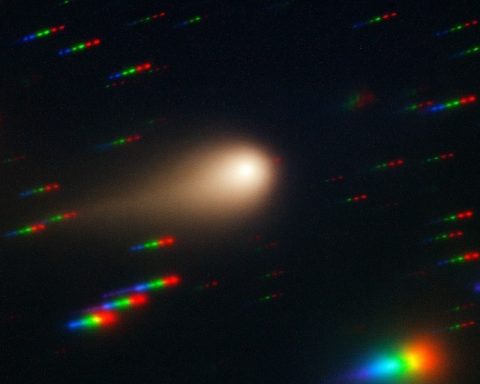- On July 31, 2025, NASA’s Crew-11 mission to the ISS was scrubbed due to weather, with liftoff canceled just over a minute before launch and the crew—Zena Cardman, Mike Fincke, Kimiya Yui, and Oleg Platonov—set to retry on Aug. 1 at 11:43 a.m. ET.
- SpaceX Falcon 9 booster B1094 landed at Cape Canaveral’s Landing Zone 1 after the Crew-11 attempt, reportedly the final planned use of LZ-1 under new Space Force rules.
- The Crew-11 mission marked the sixth flight of SpaceX’s Crew Dragon Endeavour, setting a new reuse record for SpaceX crew capsules.
- By Aug. 2, Crew-11 docked with the ISS after a 39-hour transit.
- SpaceX’s Starlink Group 13-4 launched July 31 from Vandenberg Space Force Base carrying 19 Starlink satellites, using Falcon 9 booster B1071.
- The Starlink 13-4 mission achieved a polar orbit insertion about an hour after liftoff, with all 19 satellites deployed as planned.
- Observers noted the webcast omitted the second-stage video and fairing separation views, fueling speculation that covert rideshare satellites might be hitchhiking with the Starlinks.
- China launched Pakistan’s PRSS-01 Earth observation satellite on July 31 at 10:00 a.m. Beijing time from Xichang via a Kuaizhou-1A rocket, marking Pakistan’s second major remote-sensing craft after PRSS-1 (2018).
- NISAR, a NASA-ISRO collaboration, launched on July 30 at 5:40 p.m. IST on ISRO’s GSLV Mark II, a $1.5 billion mission carrying a 2.3-ton satellite into a 463-mile-high polar orbit 18 minutes after liftoff, using dual L-band and S-band radar with a 12-meter antenna for a mission life of at least five years.
- Blue Origin’s NS-34 is targeted for Aug 3 with six civilian passengers, including Justin Sun, 34, on a mission lasting about 10–12 minutes, marking Blue Origin’s 14th crewed flight of 2025.
Crew-11 Astronaut Launch Scrubbed, Then Success on Second Try
NASA’s highly anticipated Crew-11 mission to the International Space Station faced a last-minute scrub on July 31 due to an unexpected weather violation. Mission control called off the launch just over a minute before liftoff, when a bank of cumulus clouds drifted within a 10-mile safety radius of the pad [1] [2]. “Unfortunately, the weather is just not playing along,” NASA’s launch commentator Derrol Nail explained as thunderheads rolled in, noting that a Falcon 9 rocket should never pierce a tall storm cloud due to lightning risk [3]. The four international crew members – NASA’s Zena Cardman and Mike Fincke, JAXA’s Kimiya Yui, and Roscosmos cosmonaut Oleg Platonov – had to stand down and wait another day [4].
Teams quickly retargeted Friday, Aug. 1 at 11:43 a.m. ET for a second launch attempt [5] [6]. The next day, the weather cooperated and SpaceX’s Falcon 9 successfully blasted off from Kennedy Space Center, sending Crew Dragon Endeavour on its way to orbit. This marked the sixth flight of Endeavour – a new reuse record for SpaceX’s crew capsules [7]. By Aug. 2, Crew-11 docked with the ISS, delivering its new crew after a 39-hour transit. Notably, the Falcon 9’s first stage (booster B1094) landed back at Cape Canaveral’s Landing Zone 1 – reportedly the final planned use of LZ-1 before SpaceX shifts all booster landings to facilities at their launch pads in compliance with new Space Force rules [8]. With this mission, SpaceX and NASA achieved another seamless crew delivery, despite the 24-hour delay, and continued a streak of rapid reusability in human spaceflight. (Sources: Space.com, Spaceflight Now) [9] [10]
ISS Leak Lingers as NASA and Roscosmos Discuss Future
In orbit, the International Space Station grappled with a nagging technical issue: an air leak in one of its Russian modules that just won’t quit. Roscosmos had hoped that recent repairs finally sealed the slow leak, but on July 31 officials confirmed the problem persists [11]. The minor but chronic leak has been an ongoing concern, requiring periodic cabin pressure adjustments. While not immediately dangerous, it underscores the aging infrastructure on the 25-year-old orbital outpost and the need for vigilance in station maintenance [12]. Engineers from NASA and Roscosmos continue to troubleshoot this long-running issue on the Russian segment of the ISS.
Meanwhile, in a rare moment of space diplomacy, the heads of NASA and Roscosmos met face-to-face in Florida to talk about the station’s future and beyond. Sean Duffy, NASA’s acting Administrator, hosted Dmitry Bakanov, Director General of Roscosmos, at Kennedy Space Center on July 31 – their first in-person meeting since 2018 [13]. The timing was notable: the Russian delegation was invited to watch the Crew-11 launch (which was postponed by weather to the next day) [14]. During talks, the two chiefs “discussed continued cooperation and collaboration in space,” according to NASA [15]. Roscosmos stated the meeting covered plans for “further work on the ISS, cooperation on lunar programs, [and] joint exploration of deep space,” among other topics [16]. This outreach comes amid strained U.S.-Russia relations on Earth, but it signals a commitment to maintaining the partnership in orbit and even exploring a possible rekindling of Moon cooperation [17]. With the ISS agreement currently set through 2028, both sides seem interested in finding common ground to extend their long-running collaboration in human spaceflight. (Source: Reuters) [18] [19]
SpaceX’s Starlink Launch Sets Reuse Record (and Raises Eyebrows)
SpaceX notched yet another Falcon 9 launch on July 31, this time from foggy Vandenberg Space Force Base in California – but something about it was unusual. The mission, carrying a batch of 19 Starlink internet satellites, lifted off at 11:32 a.m. local Pacific time (2:32 p.m. EDT / 18:32 UTC) and successfully deployed its payload to orbit [20] [21]. On the surface it was routine – SpaceX’s fifth Starlink launch of the month – yet observers noticed SpaceX’s webcast omitted the typical second-stage video and fairing separation views [22]. In the past, such intentional blackouts have hinted that classified “rideshare” satellites might be covertly hitchhiking alongside the Starlinks [23]. SpaceX had announced 19 Starlink v2 Minis on board (a slightly smaller count than usual), fueling speculation that one or more secret Starshield payloads for the U.S. government could have been tucked into the stack [24] [25]. The exact number of satellites will be confirmed once independent trackers catalog the objects in orbit.
Regardless of hidden cargo, the mission was a textbook success. It achieved a polar orbit insertion about an hour after liftoff, and SpaceX later confirmed all 19 Starlink satellites were deployed as planned [26]. The Falcon 9 booster – serial B1071 – made headlines of its own by completing its 27th flight, one of the highest reuse counts to date in SpaceX’s fleet [27]. This veteran booster, in service since 2022, touched down safely on a droneship off California’s coast, extending SpaceX’s record of booster reusability. The Starlink Group 13-4 mission exemplifies SpaceX’s rapid launch cadence (about five Falcon 9 launches in July 2025 from California alone) and its knack for pushing the envelope with rocket reuse and potential dual-purpose missions [28] [29]. (Source: Spaceflight Now) [30] [31]
China Launches Pakistan’s New Earth Observation Satellite
In a sign of growing international partnerships in space, China helped Pakistan take a big step forward on July 31 with the launch of Pakistan’s latest remote sensing satellite. At 10:00 a.m. Beijing time that day, a Chinese Kuaizhou-1A solid-fueled rocket roared off the pad at Xichang Satellite Launch Center, carrying Pakistan’s PRSS-01 Earth observation satellite into orbit [32]. The launch was successful – the satellite was inserted into its planned orbit – and marked a milestone in China-Pakistan space cooperation. PRSS-01 (short for Pakistan Remote Sensing Satellite) will be used for land resource mapping, urban planning, and disaster monitoring, according to officials [33]. This is Pakistan’s second major remote-sensing craft, following PRSS-1 launched in 2018, and will significantly enhance the country’s indigenous Earth-observation capabilities in areas like agriculture, infrastructure development and natural hazard early warning [34] [35].
The mission also highlights China’s emergence as a go-to launch provider for allied nations. The Kuaizhou-1A rocket – operated by ExPace, a commercial subsidiary of CASIC – has had a busy year launching small satellites. By ferrying Pakistan’s $◆$ satellite to space, China further cemented its role in helping partner countries build space infrastructure. Pakistani officials hailed the launch as a “significant milestone” for their national space program and an example of the fruitful collaboration under the China-Pakistan Economic Corridor umbrella [36] [37]. For China, which also lofted batches of its own “Guowang” internet satellites this week, it was one launch of several – underscoring an increasingly crowded launch schedule aimed at rivaling other space superpowers [38] [39]. (Sources: Xinhua, SpaceNews) [40]
U.S.-India NISAR Radar Satellite Lifts Off to Map the World
Another groundbreaking mission took to the skies this week – this one the product of a NASA–ISRO collaboration years in the making. On July 30 (just before our roundup window), India’s space agency ISRO launched NISAR, a $1.5 billion Earth-observing satellite that NASA jointly developed to monitor minute changes in Earth’s land and ice. The NISAR satellite – short for NASA-ISRO Synthetic Aperture Radar – rode an Indian GSLV Mark II rocket to orbit at 5:40 p.m. IST on Wednesday (8:10 a.m. EDT) [41]. About 18 minutes after liftoff, the 2.3-ton spacecraft was deployed into a 463-mile-high polar orbit, and mission controllers confirmed India’s rocket had “successfully and precisely” inserted NISAR into its target orbit [42]. This marked the first-ever radar imaging satellite mission between the U.S. and India, and it carries some truly advanced technology. NISAR is the world’s first satellite to operate dual radar frequencies (L-band from NASA and S-band from ISRO) simultaneously, allowing it to detect ground movements as subtle as 1 cm over nearly the entire globe [43] [44].
Once operational, NISAR will scan the planet every 12 days with an enormous 12-meter radar antenna, observing phenomena like ice sheet retreat, groundwater loss, landslides, volcano deformation, and the effects of climate change on ecosystems [45] [46]. Scientists anticipate a treasure trove of open data to improve disaster forecasting and environmental research. “The entire globe is going to benefit from this great accomplishment,” ISRO Chairman V. Narayanan said after the successful launch, emphasizing that NISAR’s data will be freely available worldwide [47]. NASA’s Deputy Associate Administrator Casey Swails hailed NISAR as a “pathfinder” mission – one that showcases what the U.S. and India can achieve together in space [48]. The two agencies worked closely for over a decade on NISAR, integrating their hardware and expertise, and this success comes on the heels of India’s Chandrayaan-3 lunar landing and amid plans for future cooperation. With at least a 5-year mission ahead, NISAR promises to set a new standard in precision Earth monitoring, while also strengthening the bond between the world’s largest democracies in space endeavors [49] [50]. (Sources: Reuters, Space.com) [51] [52]
Blue Origin Readies Next Space Tourist Launch
Blue Origin – the private space company founded by Jeff Bezos – made news of its own as July turned to August by preparing for its next suborbital tourism flight. The company announced it is targeting Sunday, Aug. 3 for the launch of New Shepard NS-34, which will carry a crew of six civilian passengers on a short hop to the edge of space [53] [54]. Topping the manifest is 34-year-old Justin Sun, a cryptocurrency billionaire who famously placed a $28 million bid in 2021 for a New Shepard seat [55]. (Sun couldn’t fly back then due to scheduling conflicts, but now he’s seizing his chance.) He’ll be joined by a diverse group: a U.S. real estate investor, a Turkish tech executive, a Puerto Rican meteorologist, a British philanthropist, and an American entrepreneur [56]. This eclectic crew will become Blue Origin’s 14th human spaceflight cohort, enjoying a few minutes of weightlessness and Earth views through New Shepard’s big windows before returning safely to West Texas.
While the flight itself falls just outside our July 31–Aug 1 window, the buzz around NS-34 was building this week. Blue Origin rolled out the rocket and confirmed all systems go, pending final checks [57]. NS-34 will be the company’s fourth crewed launch of 2025, underscoring a steady cadence in Blue Origin’s space tourism operations. Each New Shepard mission lasts only ~10–12 minutes from liftoff to capsule landing, but demand remains strong for these bucket-list rides to space. The inclusion of a high-profile figure like Justin Sun (and the public reveal of a mission patch rich with personal symbols for each passenger) has kept media attention high [58] [59]. If all goes well on Aug. 3, Blue Origin will notch another successful commercial flight – showing that suborbital space tourism is becoming almost routine, even as it retains its flash and thrill. (Source: Space.com) [60] [61]
Each of these stories from July 31 and Aug 1, 2025 highlights the rapid pace and global nature of today’s space sector. From a weather-delayed astronaut launch in Florida to satellites riding Chinese rockets in Sichuan, and from new climate science tools born of U.S.-Indian teamwork to behind-the-scenes policy meetings bridging East and West – it’s been a momentous 48 hours above Earth. As expert voices have noted, these developments carry forward an era of unprecedented collaboration, competition, and innovation beyond our planet [62] [63]. The coming days will surely bring even more surprises, but for now, the world can celebrate these latest milestones in our shared journey to the stars.
Sources: NASA; Spaceflight Now; Space.com; Reuters; Xinhua; SpaceNews; Blue Origin press. [64] [65]
References
1. www.space.com, 2. www.space.com, 3. www.space.com, 4. www.space.com, 5. spaceflightnow.com, 6. www.space.com, 7. www.space.com, 8. spaceflightnow.com, 9. www.space.com, 10. spaceflightnow.com, 11. spacenews.com, 12. spacenews.com, 13. www.reuters.com, 14. www.reuters.com, 15. www.reuters.com, 16. www.reuters.com, 17. www.reuters.com, 18. www.reuters.com, 19. www.reuters.com, 20. spaceflightnow.com, 21. spaceflightnow.com, 22. spaceflightnow.com, 23. spaceflightnow.com, 24. spaceflightnow.com, 25. spaceflightnow.com, 26. spaceflightnow.com, 27. spaceflightnow.com, 28. ts2.tech, 29. spaceflightnow.com, 30. spaceflightnow.com, 31. spaceflightnow.com, 32. english.news.cn, 33. english.news.cn, 34. tribune.com.pk, 35. tribune.com.pk, 36. english.news.cn, 37. www.facebook.com, 38. ts2.tech, 39. ts2.tech, 40. english.news.cn, 41. www.space.com, 42. www.space.com, 43. www.reuters.com, 44. www.reuters.com, 45. www.reuters.com, 46. www.space.com, 47. www.reuters.com, 48. www.reuters.com, 49. www.reuters.com, 50. www.reuters.com, 51. www.reuters.com, 52. www.reuters.com, 53. www.space.com, 54. www.space.com, 55. www.space.com, 56. www.space.com, 57. www.space.com, 58. www.space.com, 59. www.space.com, 60. www.space.com, 61. www.space.com, 62. www.reuters.com, 63. www.reuters.com, 64. www.space.com, 65. www.reuters.com










